


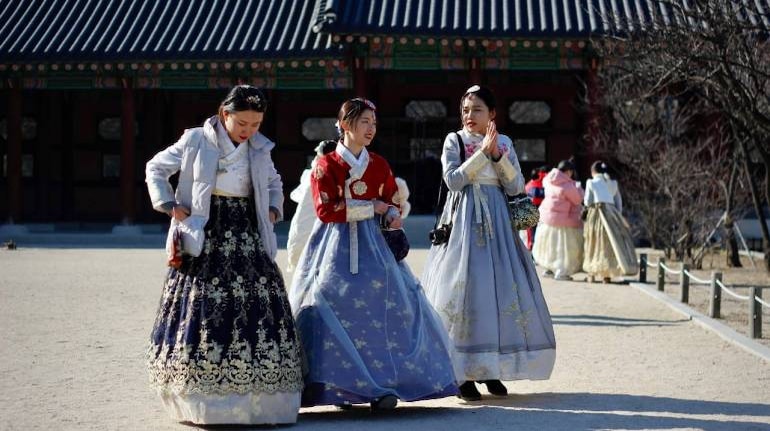
Within living memory, South Korea has rapidly evolved from a country ravaged by war in the late 1950s to a leading cultural powerhouse by the early 2000s. Its capital, Seoul, is at the heart of the fashion fest that has turned millions into copycats and cult followers.
I still remember that night. I sat on the edge of the white rattan sofa staring at my 13-inch Mac as South Korean Minju Kim — shy, slightly giggly, in a careless pony tail and a pinafore — was sewing the white wedding dress, the patterned loose pant paired with an apron dress, a floral maxi dress and a pink crop jacket for the grand finale of Next in Fashion (2020) on Netflix. I was quietly rooting for Minju Kim, the young Seoul designer known for her bold prints, vibrant colours and that cheerful energy hanging from the hems. I wasn’t new to Minju Kim. I knew she had designing since 2015 and has sewn costumes for K-pop bands BTS and Red Velvet. That night, Minju Kim was crowned the Next In Fashion winner.
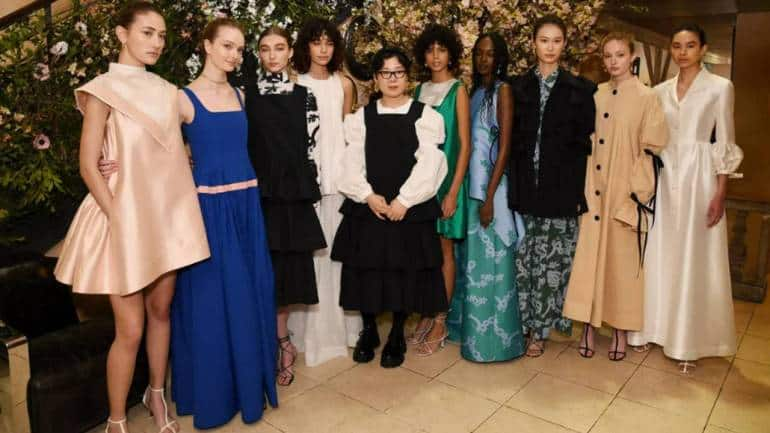 Minju Kim’s Net-a-Porter collection. (Photo: Twitter)
Minju Kim’s Net-a-Porter collection. (Photo: Twitter)That was not my first brush with South Korean fashion. Hallyu, as they call it. The Korean wave that has swept the world with such swiftness that everyone is enamoured — and turning copycats. Streetwear. Co-ord sets. A-line skirt with a button-down shirt or a simple long-sleeved top, a beret, and loafer. Oversized coats. Beanies and scarves. Pastels and bright candy colours on the same lean body with glass-skin.
Much before Minju Kim stole the fashion show, I had felt frumpy in Seoul. In bone-biting cold, I was wrapped in a fur of a hundred merinos while women in Seoul walked around in tiny skirts, large boots, fancy coats and fancier hats. As I waited on the other end of the street, the women crossed the zebra lines as models do on the ramp — almost as if photographs from a fashion catalogue were walking out of the pages on to the pedestrian zebra lines. And men? Mani-ed, pedi-ed, clean-shaven, moussed, dressed impeccably both in neat cuts and careless streetsy. Not many men can look so voguish in their sartorial informality. The men in Seoul do.
South Korean fashion has come a long way from the Joseon era (1392-1897) when the hanbok was all the rage to the Japanese Occupation when men had to snip off their top buns and women took to wearing trousers, the re-imagining of military wear after the Korean war and the birth of counter culture in 1970s to protest against the harsh political environment and the recent impact of all things K-pop.
In the new year, let’s have a quick look at all the fashion must-see, must-visit, must buy, must-do and the fashion don’ts in Seoul:
2023 K-Fashion Trends· Oversized t-shirts
· Baggy pants
· Bucket hats
· Ribbed shirts
· Pastel colours
· A-line skirts.
· Modern hanbok (hanbok is the traditional Korean dress)
Best shopping options: YesStyle, Won Yong’s, Unnielooks, Kooding
Best in South Korean fashion:Gentle Monster: Sunglasses
Andersson Bell: Korean style with a minimalist Scandinavian sensibility
Yuul Yie: Shoes with unusual colour combination, architectural block heels and unique shapes
Kim Young Jin: Traditional Korean clothing
Reike Nen: Footwear and handbags
EENK: Sustainable couture
Tibaeg: T-shirts
Steve J. and Yoni P: Denim
MUNN: Generally called K-designer royalty
DeMaker: Revamped classics and unique interpretations of current trends
Lucky Chouette: Suited for the young
D-Antidote: Cross over between menswear and womenswear, with a gender fluid style
R-Shemiste: Grunge-style
87mm: Urban-chic vibe
Ader Error: Different kind of minimalism for everyday street fashion
Lie Sang Bon: Traditional influences and innovative techniques
BMUET(TE): Androgynous and dramatic silhouettes
BonBom: Biker-couture style
Cahiers: French-inspired label
Vimun Studio: Women’s wear known for classic and casual silhouettes
What not to wear in Seoul· Leggings are for the gym, not in other places
· Cleavage-showing tops
· Backless clothing
· Bikinis are a big no-no. Wear shorts or monokinis
· Off-shoulder or one-shoulder dress/top
· Tank top (spaghetti strap) with exposed chest
· Jogging in sports bra
· Men, do not roam around shirtless
· No bold colours for men
· Not too short shorts for men; should be above the knee
· No jeans and Converses for business meetings
Where to shop in Seoul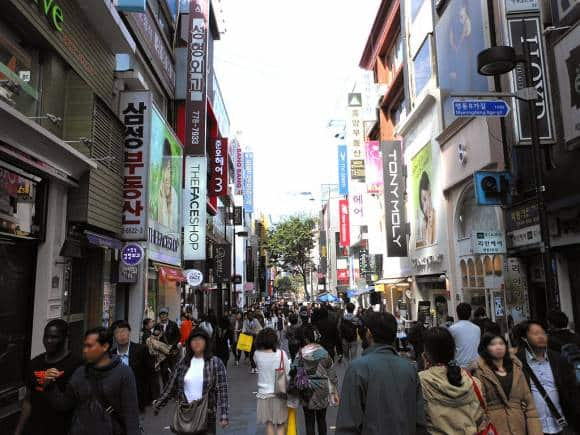 Myeongdong Market, Seoul. (Photo: Wikimedia Commons)
Myeongdong Market, Seoul. (Photo: Wikimedia Commons)For affordable fashion: Myeongdong Market that has over 1,000 outlets selling clothes, shoes, accessories, jewellery, and handbags.
For luxury brands: Apgujeong, the upmarket shopping district is lined with chic designer shops, department stores and beauty clinics.
For all things vintage: Insadong district has dozens of vintage shops, antique shops, bookshops and teahouses.
Must see: Hallyu- the Korean Wave in Victoria & Albert Museum (London)"Hallyu! The Korean Wave" exhibition explores the makings of the Korean Wave through cinema, drama, music and fandoms, and underlines its cultural impact on the beauty and fashion industries. The exhibition features around 200 objects alongside pop culture ephemera and digital displays across four thematic sections.
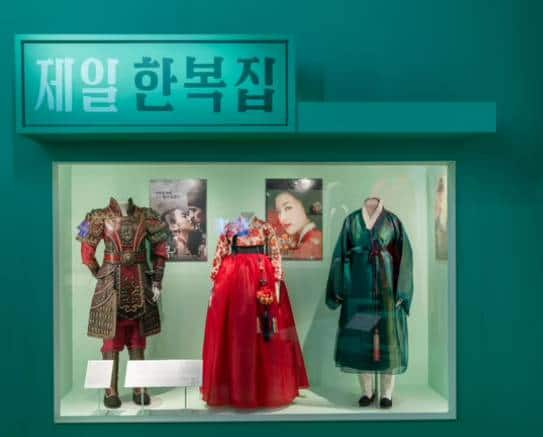 'Hallyu! The Korean Wave' exhibition is on till June 25, 2023 at the Victoria & Albert Museum, London. (Photo: vam.ac.uk)
'Hallyu! The Korean Wave' exhibition is on till June 25, 2023 at the Victoria & Albert Museum, London. (Photo: vam.ac.uk)The Making K-Beauty & Fashion section features cosmetics packaging from the 13th century to the present day and over 20 looks by contemporary hanbok and fashion designers from Korea and the Korean diaspora. On display is a look specially created for the V&A by acclaimed stylist Suh Younghee, alongside a K-pop hanbok by C-ZANN E, a pink jacket by Danha, and a purple cheollik dress by Tchai Kim, drawing their inspiration from traditional garments and patterns. The section also features hanbok-inspired daily wear designed for and by a younger generation, including looks by Ji Won Choi, Darcycom, and a contemporary hanbok overcoat BaekOak Soo designed for RM from BTS in 2018.
The exhibition is on until June 25, 2023Must visit: Simone Handbag Museum, Seoul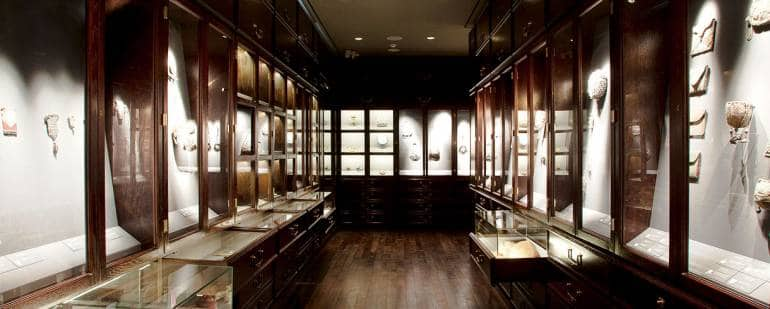 Simone Handbag Museum, Seoul. (Photo: simone.co.kr)
Simone Handbag Museum, Seoul. (Photo: simone.co.kr)Housed in a 10-storey handbag-shaped building, the Simone Handbag Museum is the world’s first museum dedicated entirely to handbags. Dating from the 1500s until the 21st century, the museum has approximately 350 handbags of immense value in the fashion history collected from renowned official auctions and international collectors around the globe. The Historical Gallery was made with wooden cabinets in harmony with the atmosphere of the times. It feels like a private collection space owned by a noble family during the Victorian era. The Modern Gallery created with white metals presents it-bags from the 1900s to the present time. It looks like a laboratory and also reminds viewers of the backside of the stage where props are in piles.
Discover the latest Business News, Sensex, and Nifty updates. Obtain Personal Finance insights, tax queries, and expert opinions on Moneycontrol or download the Moneycontrol App to stay updated!
Find the best of Al News in one place, specially curated for you every weekend.
Stay on top of the latest tech trends and biggest startup news.